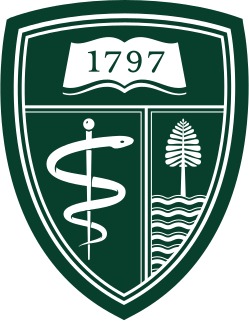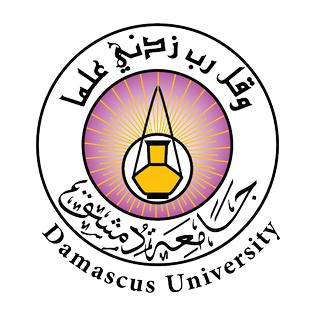
The University of California, San Francisco (UCSF) is a public land-grant research university in San Francisco, California. It is part of the University of California system and it is dedicated entirely to health science. It is a major center of medical and biological research and teaching.
Stanford University School of Medicine is the medical school of Stanford University and is located in Stanford, California. It traces its roots to the Medical Department of the University of the Pacific, founded in San Francisco in 1858. This medical institution, then called Cooper Medical College, was acquired by Stanford in 1908. The medical school moved to the Stanford campus near Palo Alto, California, in 1959.

The American University of Beirut (AUB) is a private, non-sectarian, and independent university chartered in New York with its campus in Beirut, Lebanon. AUB is governed by a private, autonomous board of trustees and offers programs leading to bachelor's, master's, MD, and PhD degrees.

Stanford University Medical Center is a medical complex which includes Stanford Health Care and Stanford Children's Health. It is consistently ranked as one of the best hospitals in the United States and serves as a teaching hospital for the Stanford University School of Medicine. In 2020-21, it was ranked by the US News as the 4th-best hospital in California and 13th-best in the country.

The Indiana University School of Medicine has nine campuses throughout Indiana; the principal research and medical center is located on the Indiana University – Purdue University Indianapolis campus in Indianapolis. With 1,409 M.D. Program students and 158 Ph.D. students in 2017, IU is one of the largest allopathic medical schools in the United States. The school offers several joint-degree programs, including an MD/MBA, MD/MA, MD/MPH, and an MD-PhD Medical Scientist Training Program. The university is the American medical school with the largest number of physicians in the United States per the 2018 Federation of State Medical Boards Survey with 11,828 licensed physicians.
St. George's University is a private medical school and international university in Grenada, West Indies, offering degrees in medicine, veterinary medicine, public health, the health sciences, nursing, arts and sciences, and business.

The Geisel School of Medicine at Dartmouth is the graduate medical school of Dartmouth College in Hanover, New Hampshire. The fourth oldest medical school in the United States, it was founded in 1797 by New England physician Nathan Smith. It is one of seven Ivy League medical schools.
Beirut Arab University (BAU) is a Lebanese private university located in Beirut, Lebanon. It was founded by the Lebanese El-Bir and Ihsan Society in. The university is ranked among the top universities in the Arab Region by 2015/16 QS World University Rankings.

The University of Damascus is the largest and oldest university in Syria, located in the capital Damascus and has campuses in other Syrian cities. It was founded in 1923 through the merger of the School of Medicine and the Institute of Law. Until 1958 it was named the Syrian University, but the name changed after the founding of the University of Aleppo. There are nine public universities and more than ten private ones in Syria.

Western University of Health Sciences (WesternU) is a private university with its main campus in Pomona, California, with an additional osteopathic medical school in Lebanon, Oregon. WesternU offers osteopathic medical, dental, optometry, and podiatry degrees along with nursing, physician assistant studies, physical therapy, pharmacy, biomedical sciences, and veterinary medicine. With an enrollment of 3,814 students (2020–21), WesternU offers 21 academic programs in nine colleges.

The University of Alabama at Birmingham Heersink School of Medicine is a public medical school located in Birmingham, Alabama, United States with branch campuses in Huntsville, Montgomery, and at the University of Alabama College of Community Health Sciences in Tuscaloosa. Residency programs are also located in Selma, Huntsville and Montgomery. It is part of the University of Alabama at Birmingham (UAB).
Saint Joseph University is a private Catholic research university in Beirut, Lebanon, founded in 1875 by the Jesuits. According to the 2012–2013 Times Higher Education World University Rankings, powered by Thomson Reuters, Saint Joseph University ranks as the second best university in Lebanon, and among the top academic institutions in the Middle East. Its alumni include numerous Lebanese presidents, ministers, philosophers, intellectuals, clerics and beyond. As Lebanon's oldest and main French medium university, while promoting Lebanese culture, admission openly disregards any ethno-religious affiliations, encouraging trilingualism of French, Arabic and English. Additionally, it is known for its university hospital, Hôtel-Dieu de France.

Sami Ibrahim Haddad, Arabic: سامي ابراهيم حداد was a doctor, surgeon and writer. He was born in Palestine and spent most of his life in Lebanon.

The University of Balamand is a private institution, secular in its policies and approach to education. It welcomes faculty, students, and staff from all faiths and national or ethnic origins. The university is located in the northern district of El-Koura, Lebanon. It was founded by the Orthodox Patriarch Ignatius IV of Antioch in 1988. The university's main campus is adjacent to Balamand Monastery, but it has two other campuses in Beirut: One is in Sin el Fil, which houses the majority of the Lebanese Academy of Fine Arts, and the other neighbors Saint George Hospital in Achrafieh, which houses the faculty for medicine and medical sciences. It also has campuses in Akkar and Souk El Gharb.
Dr. Kamal Badr is a Lebanese-American physician and scientist who has been Professor of Medicine and Chair of the Department of Internal Medicine at the American University of Beirut from July 2000 to late 2006. He then was named Founding Dean of the Lebanese American University’s new medical school, a position he held until September 1, 2010. He returned to the American University of Beirut in October 2010, where he is Associate Dean for Medical Education.

The Ohio State University College of Dentistry is one of the graduate and professional schools of The Ohio State University. The college is the fourth largest public dental school in the U.S. and consists of nine academic divisions representing all major dental specialties. In addition to the Doctor of Dental Surgery (D.D.S.) and Bachelor of Science in Dental Hygiene degrees, the Ohio State College of Dentistry offers specialty training programs, advanced training programs, MS programs, and a Ph.D. program in Oral Biology. Outreach and Engagement activities include over 60 active programs and more than 42 extramural sites, which continue to expand.

The University of Sheffield Medical School is a medical school based at the University of Sheffield in Sheffield, South Yorkshire, England. The school traces its history back to at least 1828. It operated independently until its merger with Firth College and Sheffield Technical School in 1897, and is now an integral part of Sheffield's Faculty of Medicine, Dentistry and Health.

Stanford Medicine traces its history back to 1858 when Elias Samuel Cooper, a physician in San Francisco, California, founded the first medical school in the Western United States. That school went through many changes, including a change of name to Cooper Medical College, a takeover by Stanford University in 1908, and a move from San Francisco to the Stanford campus near Palo Alto, California in 1959.

Lloyd Brooks Minor M.D. is an American surgeon, researcher, educator, and academic administrator. Since December 2012, he has served as the Carl and Elizabeth Naumann Dean of Stanford University School of Medicine at Stanford University. Previously, he was the provost of Johns Hopkins University.

Lyman Maynard Stowe was an American physician and academic administrator. He served as the first dean of the University of Connecticut School of Medicine. The Lyman Maynard Stowe Library at the UConn Health Center was named in his honor.